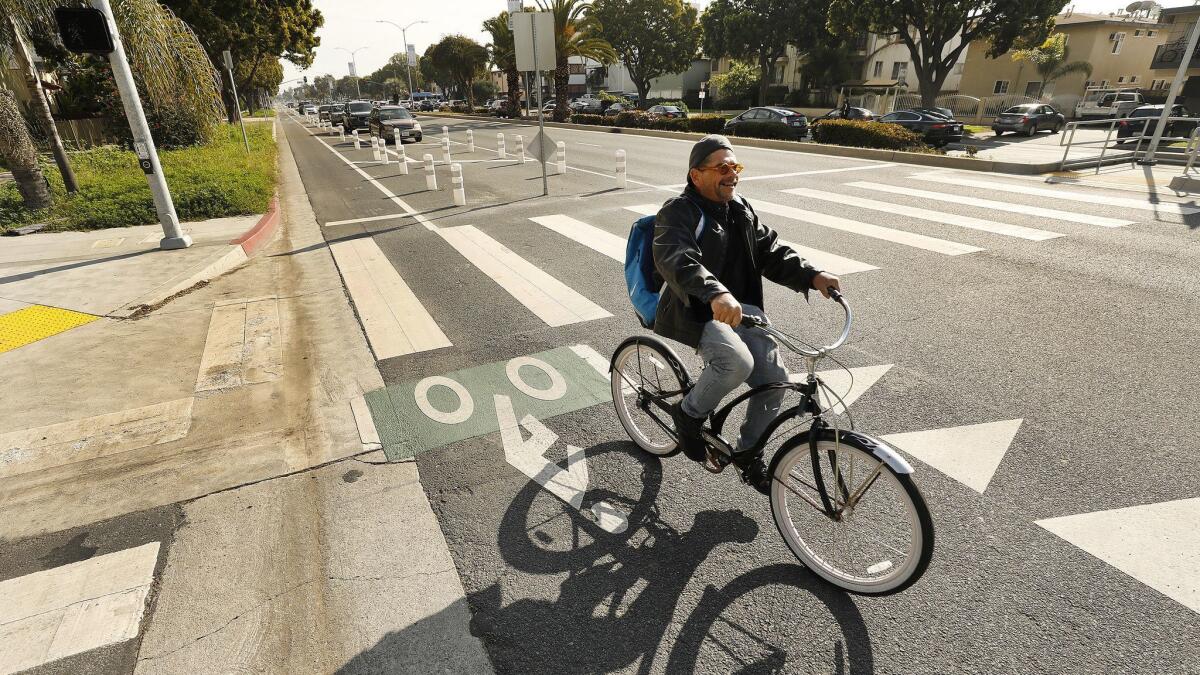Using California gas tax to reduce traffic lanes? Not how it should be spent, some say

Reporting from Sacramento — Two years after state lawmakers boosted the gas tax with a promise to improve California streets, some cities have raised the ire of drivers by spending millions of the new dollars on “road diet” projects that reduce the number and size of lanes for motor vehicles.
Projects have touched off a debate as taxpayer advocates and motorists complain that the higher gas taxes they are paying for smoother trips will actually fund projects that increase traffic congestion.
Cities counter that they are making the roads safer by slowing traffic and that motorists benefit by being separated from cyclists and scooter users in the bike lanes.
Gas tax money can legally go to such projects, but that does not mean it should, said David Wolfe, legislative director for the Howard Jarvis Taxpayers Assn., which opposed the original gas tax increase and supported an unsuccessful statewide ballot measure last year to repeal it. It has since continued to watch and criticize how state and local governments are spending the money.
“When Proposition 6 was on the ballot, all voters heard was money would go to road repair and maintenance,” Wolfe said. “They want roads to be repaired. They don’t want roads to be taken away with their taxpayer dollars.”
Senate Bill 1, the legislation that increased the gas tax, includes $100 million in gas tax money annually designated for bicycle and pedestrian projects, which are key elements of many road diets.
The bulk of SB 1 money, $2.27 billion in the first year, went to state projects to repair and maintain roads, while $750 million annually was set aside for public transportation capital projects and operating expenses.
Sacramento, La Quinta and San Luis Obispo are among the cities that have been awarded gas tax dollars to create protected bike lanes by eliminating or reducing the size of lanes used by motor vehicles.
Wolfe’s office in Sacramento overlooks J Street, a one-way road and major traffic corridor in the city center that was recently reduced from three lanes to two. The space taken from motorists was used to create a protected bike lane buffered from traffic by parking spaces moved away from the curb.
The goal of the project is not just to make Sacramento a more bicycle-friendly city but also to improve public safety, Sacramento Mayor Darrell Steinberg said.
“These were streets with some of the highest numbers of fatal and serious crashes in the city,” Steinberg said. “When we looked at why, the primary collision factor on the streets was unsafe speeds. And one of the easiest and most cost-effective ways to reduce the speeds is to reduce the number of travel lanes.”
A 2010 study by the Federal Highway Administration found a 19% decrease in automobile accidents where road diets were used in California and Washington state and a 47% reduction in Iowa.
The money for safer bike lanes was fought for by groups including the California Bicycle Coalition, which advocates for cyclists.
“Safety is important, obviously, but it’s not just about safety,” said Dave Snyder, executive director of the coalition. “It’s about economy and equity. We can’t fix traffic without giving people safe alternatives to cars.”
The idea of reducing lanes for motor vehicles has been around for years and has been controversial just as long.
In Los Angeles, residents have sued the city over its decision to reduce the number of traffic lanes on a stretch of Venice Boulevard in Mar Vista to make space for a protected bicycle lane.
That project, funded before SB 1 was approved, was part of a larger plan that eliminated some nine miles of Westside traffic lanes in Mar Vista and Playa del Rey. Residents took the city to court, and some of the road diets were reversed.
“It’s creating gridlock on Venice Boulevard, which is then causing cut-through traffic into our neighborhoods,” said Selena Inouye, board president of the Westside Los Angeles Neighbors Network, a group formed in response to the project.
Mayor Eric Garcetti did not respond to a request for comment on the road diet projects. Also unavailable was L.A. City Councilman Mike Bonin, a strong advocate of the Venice Boulevard bike lanes.
Inouye, a retired social worker, said having motorists pay higher gas taxes so the money can be used to reduce the capacity of roads is contradictory.
She and her husband are paying more than $4 a gallon for gas at her local service station, she said, a price that has been increased by the state gas tax.
“The money should be used to help with congestion overall, and I don’t think that road diets help congestion. I think they cause congestion,” Inouye said.
A study commissioned by Los Angeles said that the Venice Boulevard road diet made the corridor safer but that eastbound evening drive times along the 0.8-mile stretch increased by more than four minutes in the first three months after the bike lane was installed, to 7 minutes, 4 seconds. After a year, with some design changes, the evening travel time fell to 3 minutes, 56 seconds.
State officials who oversee the spending of gas tax money say public safety was a key priority of SB 1 when it was debated and approved by the Legislature in April 2017. The measure is bringing in more than $5 billion annually for road and bridge repairs and expanded mass transit in the state.
The bill raised the state gas tax by 12 cents a gallon that year and provides a 5.6-cent increase this July 1.
The gas tax revenue is mainly used for the rehabilitation and replacement of roads and bridges, but some of the money can legally go to road diet projects, said Matt Rocco, a spokesman for the California Department of Transportation.
“Road diets, like other operational improvements, can help improve the flow of traffic and improve safety for the motorists, bicyclist and pedestrians,” Rocco said.
Part of the current debate is whether road diets improve the flow of traffic.
Wolfe said he has experienced frustrating delays using a nine-block stretch of J Street that has been put on a road diet.
“It’s night-and-day more congested,” Wolfe said.
The J Street project that included a road diet and repaving was paid for with $1.3 million in gas tax funds, and it is among 25 blocks on central city streets that have seen a reduction in lanes for motorists in Sacramento, with another six blocks planned.
The entire project on multiple streets has received $5 million in gas tax funds.
Wolfe and Inouye said bike lanes already existed on J Street and Venice Boulevard.
Steinberg said Sacramento motorists should not be surprised that revenue from higher gas taxes is going to road diet projects.
“The Legislature was very transparent here. They made it clear that improving safety on our roadways is one of the prime reasons for passing SB 1,” Steinberg said, adding that so far public reactions to road diets in his city have been “largely very positive.”
Assemblyman Vince Fong (R-Bakersfield) said he has heard complaints. “The congestion has gotten worse during rush-hour traffic and the morning commute,” said Fong, vice chairman of the Assembly Transportation Committee. “When people find out that it is gas tax money being used for that, there is a lot of frustration.”
No legislation has been introduced to limit the use of gas tax money to eliminate vehicle lanes. On Thursday, the state Senate approved a bill requiring Caltrans to develop policies that encourage the creation of more bikeways, sidewalks and crosswalks on state highways that are surface streets.
“If we’re serious about encouraging more people to bike and walk — which we should be — we need to ensure that the streets they are using are safe,” Sen. Scott Wiener (D-San Francisco) said.
Snyder, of the bicycle coalition, said the protected bike lanes are helping the economy by making business districts safer for pedestrians and bicyclists.
“If we want our tax money to be used to improve our quality of life, there’s no better way to spend it than on improving our streets to make our communities more livable,” he said.
A study of the projects’ effect on safety in Sacramento has not yet been completed, Steinberg said.
“But anecdotally people are saying that drivers are driving more slowly, drivers are yielding to pedestrians crossing the street more,” the mayor said.
Sign up for our Essential Politics newsletter »
Twitter: @mcgreevy99
More to Read
Get the L.A. Times Politics newsletter
Deeply reported insights into legislation, politics and policy from Sacramento, Washington and beyond. In your inbox three times per week.
You may occasionally receive promotional content from the Los Angeles Times.











